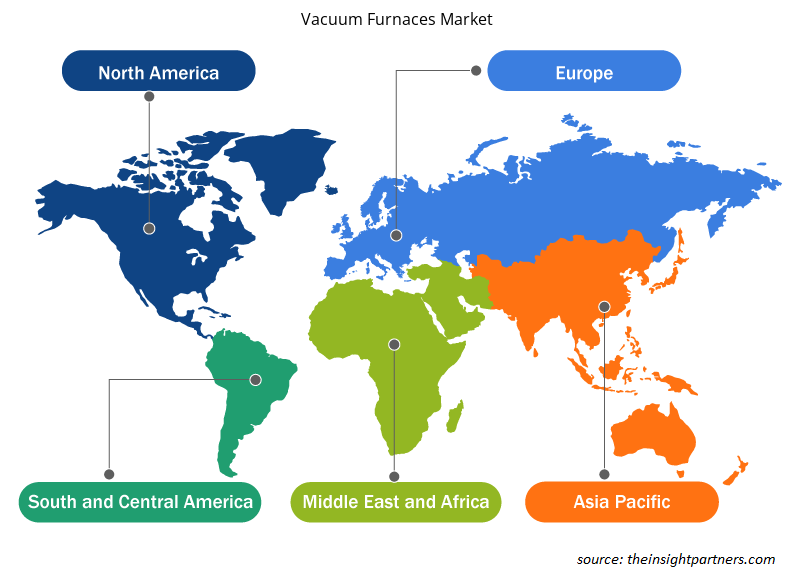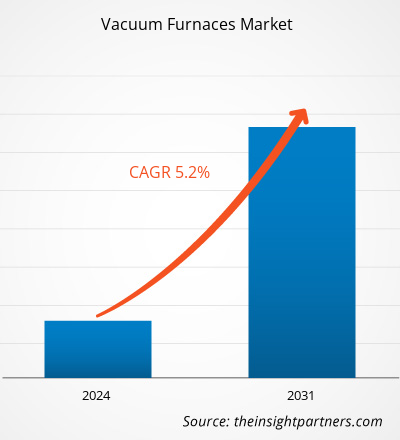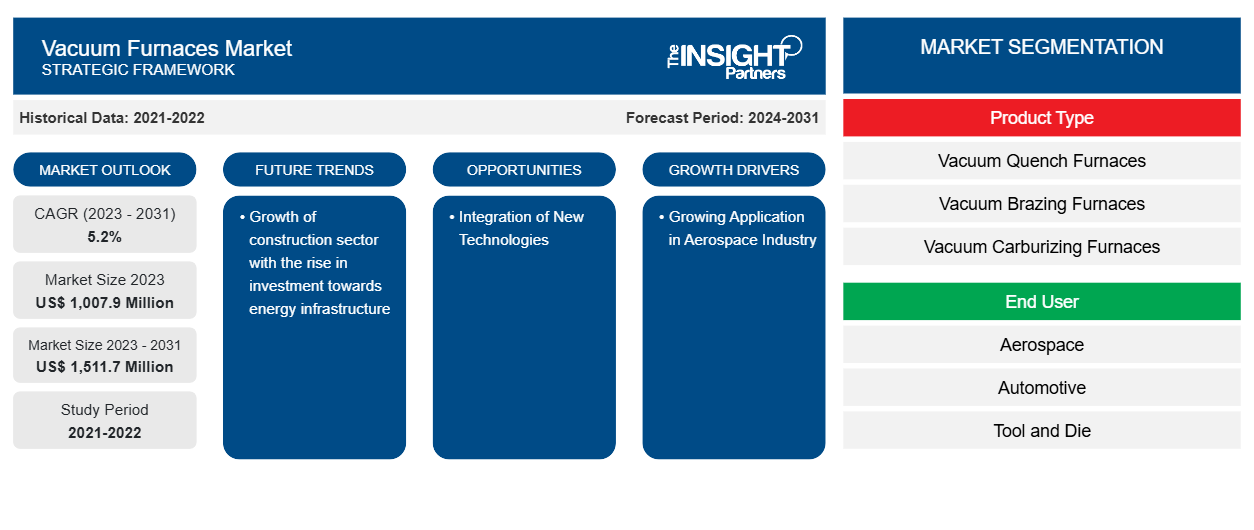Si prevede che la dimensione del mercato dei forni a vuoto raggiungerà 1.511,7 milioni di dollari entro il 2031 da 1.007,9 milioni di dollari nel 2023. Si prevede che il mercato registrerà un CAGR del 5,2% nel periodo 2023-2031. La crescita del settore delle costruzioni con l'aumento degli investimenti nelle infrastrutture energetiche rimarrà probabilmente una tendenza chiave nel mercato.CAGR of 5.2% during 2023–2031. The growth of the construction sector with the rise in investment towards energy infrastructure is likely to remain key trends in the market.
Analisi di mercato dei forni sotto vuoto
Si prevede che l'aumento della domanda di forni a vuoto da applicazioni industriali alimenterà la crescita del mercato nei prossimi anni. Inoltre, si prevede che il crescente utilizzo di forni a vuoto nell'industria aerospaziale e della difesa alimenterà la crescita del mercato nei prossimi anni. Inoltre, si prevede che la crescita del settore edile nelle regioni in via di sviluppo e sviluppate in tutto il mondo e un aumento degli investimenti verso infrastrutture energetiche per soddisfare la domanda di elettricità creeranno opportunità per i principali produttori di forni a vuoto dal 2023 al 2031.
Panoramica del mercato dei forni a vuoto
L'ecosistema dei forni a vuoto è costituito da tre principali stakeholder, quali fornitori di materie prime, produttori di forni a vuoto e utenti finali. I fornitori dei fornitori di materie prime includono le aziende che forniscono varie materie prime per l'assemblaggio e la progettazione di forni per l'applicazione desiderata. Ad esempio, alcuni dei principali tipi di prodotti sono metalli, attuatori, motori e azionamenti, tra gli altri tipi di prodotti. I produttori di forni a vuoto raccolgono materie prime per costruire una varietà di forni a vuoto per varie applicazioni per diversi settori verticali dell'industria. Le aziende del settore degli utenti finali utilizzano questi forni a vuoto per una varietà di prodotti. La tendenza crescente della strutturazione pre-stampo, Industria 4.0, l'implementazione di tecnologie come IoT e cloud computing , insieme alla crescente domanda di sistemi di automazione efficienti in tutti i settori sono alcuni dei fattori chiave che stanno alimentando la domanda di forni a vuoto.
Personalizza questo report in base alle tue esigenze
Riceverai la personalizzazione gratuita di qualsiasi report, comprese parti di questo report, o analisi a livello nazionale, pacchetto dati Excel, oltre a usufruire di grandi offerte e sconti per start-up e università
-
Scopri le principali tendenze di mercato in questo rapporto.Questo campione GRATUITO includerà analisi di dati che spaziano dalle tendenze di mercato alle stime e alle previsioni.
Driver e opportunità del mercato dei forni a vuoto
Crescente applicazione nel settore aerospaziale per favorire il mercato
L'industria aerospaziale è uno dei principali utenti finali dei forni a vuoto. Poiché il trattamento termico viene utilizzato nell'industria aerospaziale per migliorare la resistenza di vari componenti all'usura e alla corrosione, i metodi principali prevedono il trattamento termico di parti del motore sottoposte a sollecitazioni e deformazioni meccaniche. Poiché offre elevata affidabilità, un ingombro di installazione ridotto e facilità di manutenzione, il trattamento termico con forno a vuoto verticale viene utilizzato per riscaldare parti con una sezione trasversale cilindrica o parti che possono essere impilate verticalmente, che vengono comunemente lavorate nell'industria aerospaziale. I forni a vuoto vengono utilizzati per brasatura, ricottura, trattamento di soluzione, invecchiamento, tempra, distensione e altri trattamenti termici. Di conseguenza, il mercato dei forni a vuoto sta crescendo grazie all'ampia gamma di applicazioni nell'industria aerospaziale.
Inoltre, il settore aerospaziale e della difesa (A&D) è impegnato nello sviluppo di nuove tecnologie e soluzioni, ampliando le prospettive di sviluppo e stabilendo nuovi mercati. Nuove tecnologie e processi che si evolvono rapidamente e vengono commercializzati possono migliorare l'efficienza e ridurre i costi di produzione. Le tendenze nell'aumento dei viaggi aerei commerciali e dell'attività degli ordini dei clienti sono sostanzialmente migliori rispetto all'era pre-COVID-19, un presagio positivo per il business. La distribuzione globale del vaccino COVID-19 aiuta nella normalizzazione dei viaggi aerei. Pertanto, la ripresa del settore aerospaziale guida il mercato dei forni a vuoto.
Integrazione delle nuove tecnologie
Il futuro della tecnologia di lavorazione termica metallurgica è in continuo cambiamento. La tecnologia dei forni a vuoto è ben nota e utilizzata dagli industriali ingegneristici con la visione di stabilire questa tecnologia di processo come un veicolo in grado di abilitare molte delle nuove trasformazioni termo-metallurgiche dei prodotti ingegnerizzati e fabbricati di oggi. Secondo le tendenze internazionali esistenti e previste, la tecnologia dei forni a vuoto ha attualmente un potenziale significativo per continuare a svilupparsi in futuro. È una tecnologia che consentirà alla scienza dei materiali e ai suoi partner industriali di entrare facilmente nel terzo millennio. Pertanto, la tecnologia di lavorazione termica sotto vuoto svolge un ruolo essenziale nella brasatura di leghe di alluminio non ferrose geometriche complesse
Analisi della segmentazione del rapporto di mercato dei forni a vuoto
I segmenti chiave che hanno contribuito alla derivazione dell'analisi di mercato dei forni a vuoto sono il tipo di prodotto e l'utente finale
- In base al tipo di prodotto, il mercato dei forni a vuoto è suddiviso in forni di tempra a vuoto, forni di brasatura a vuoto, forni di carburazione a vuoto e altri. Il segmento dei forni di tempra a vuoto ha detenuto la quota di mercato maggiore nel 2023.carburizing furnaces, and others. The vacuum quench furnaces segment held the largest market share in 2023.
- In base all'utente finale, il mercato è classificato in aerospaziale, automobilistico, utensili e stampi, generazione di energia e altri. Il segmento aerospaziale ha detenuto la quota di mercato più grande nel 2023.
Analisi della quota di mercato dei forni a vuoto per area geografica
L'ambito geografico del rapporto sul mercato dei forni a vuoto è suddiviso principalmente in cinque regioni: Nord America, Asia Pacifico, Europa, Medio Oriente e Africa e Sud America.
L'ambito del rapporto di mercato sui forni a vuoto comprende Nord America (Stati Uniti, Canada e Messico), Europa (Germania, Francia, Italia, Spagna, Regno Unito e resto d'Europa), Asia Pacifico (Cina, India, Australia, Giappone, Corea del Sud e resto dell'Asia Pacifico), Medio Oriente e Africa (Sudafrica, Arabia Saudita, Emirati Arabi Uniti e resto del Medio Oriente e Africa) e Sud America (Brasile, Argentina e resto del Sud America). In termini di fatturato, l'Asia Pacifico ha dominato la quota di mercato dei forni a vuoto nel 2023. L'Europa è stata il secondo maggiore contributore di fatturato al mercato globale dei forni a vuoto, seguita dal Nord America.UAE, and Rest of Middle East & Africa), and South America (Brazil, Argentina, and the Rest of South America). In terms of revenue, Asia Pacific dominated the vacuum furnaces market share in 2023. Europe was the second-largest revenue contributor to the global vacuum furnaces market, followed by North America.
Approfondimenti regionali sul mercato dei forni a vuoto
Le tendenze regionali e i fattori che influenzano il mercato dei forni a vuoto durante il periodo di previsione sono stati ampiamente spiegati dagli analisti di Insight Partners. Questa sezione discute anche i segmenti e la geografia del mercato dei forni a vuoto in Nord America, Europa, Asia Pacifico, Medio Oriente e Africa e America meridionale e centrale.

- Ottieni i dati specifici regionali per il mercato dei forni a vuoto
Ambito del rapporto di mercato sui forni a vuoto
| Attributo del report | Dettagli |
|---|---|
| Dimensioni del mercato nel 2023 | 1.007,9 milioni di dollari USA |
| Dimensioni del mercato entro il 2031 | 1.511,7 milioni di dollari USA |
| CAGR globale (2023-2031) | 5,2% |
| Dati storici | 2021-2022 |
| Periodo di previsione | 2024-2031 |
| Segmenti coperti |
Per tipo di prodotto
|
| Regioni e Paesi coperti |
America del Nord
|
| Leader di mercato e profili aziendali chiave |
|
Densità degli attori del mercato dei forni a vuoto: comprendere il suo impatto sulle dinamiche aziendali
Il mercato dei forni a vuoto sta crescendo rapidamente, spinto dalla crescente domanda degli utenti finali dovuta a fattori quali l'evoluzione delle preferenze dei consumatori, i progressi tecnologici e una maggiore consapevolezza dei vantaggi del prodotto. Con l'aumento della domanda, le aziende stanno ampliando le loro offerte, innovando per soddisfare le esigenze dei consumatori e capitalizzando sulle tendenze emergenti, il che alimenta ulteriormente la crescita del mercato.
La densità degli operatori di mercato si riferisce alla distribuzione di aziende o società che operano in un particolare mercato o settore. Indica quanti concorrenti (operatori di mercato) sono presenti in un dato spazio di mercato in relazione alle sue dimensioni o al valore di mercato totale.
Le principali aziende che operano nel mercato dei forni sotto vuoto sono:
- AMG Metallurgico Avanzato
- Tecnologie del vuoto ALD
- Industrie del vuoto Centorr
- Società controllata da Chugai RO.
- Tecnologie ECM
- HHV srl
Disclaimer : le aziende elencate sopra non sono classificate secondo un ordine particolare.

- Ottieni una panoramica dei principali attori del mercato dei forni a vuoto
Notizie di mercato e sviluppi recenti sui forni a vuoto
Il mercato dei forni a vuoto viene valutato raccogliendo dati qualitativi e quantitativi dopo la ricerca primaria e secondaria, che include importanti pubblicazioni aziendali, dati associativi e database. Di seguito sono elencati alcuni degli sviluppi nel mercato dei forni a vuoto:
- HHV e ASM Technologies hanno formato una joint venture per la produzione di apparecchiature per semiconduttori. Entrambe le aziende hanno formato una joint venture 50:50. La nuova entità così formata produrrà utensili, componenti di sottosistemi e componenti per i settori dei semiconduttori e dell'energia solare. (Fonte: HHV Ltd, comunicato stampa, febbraio 2022)
- Ipsen sta ampliando le sue capacità di servizio aggiungendo test di spessore delle pareti a ultrasuoni per forni a vuoto. Questo test aiuterebbe a identificare l'integrità delle loro camere e a stimarne di conseguenza la durata. (Fonte: Ipsen, comunicato stampa, febbraio 2022)
Copertura e risultati del rapporto sul mercato dei forni a vuoto
Il rapporto "Dimensioni e previsioni del mercato dei forni a vuoto (2021-2031)" fornisce un'analisi dettagliata del mercato dei forni a vuoto che copre le seguenti aree:
- Dimensioni e previsioni del mercato dei forni a vuoto a livello globale, regionale e nazionale per tutti i principali segmenti di mercato coperti dall'ambito
- Tendenze del mercato dei forni a vuoto e dinamiche di mercato come driver, vincoli e opportunità chiave
- Analisi PEST e SWOT dettagliate
- Analisi di mercato dei forni a vuoto che copre le principali tendenze del mercato, il quadro globale e regionale, i principali attori, le normative e i recenti sviluppi del mercato
- Analisi del panorama industriale e della concorrenza che copre la concentrazione del mercato, l'analisi della mappa di calore, i principali attori e gli sviluppi recenti per il mercato dei forni a vuoto
- Profili aziendali dettagliati
- Analisi storica (2 anni), anno base, previsione (7 anni) con CAGR
- Analisi PEST e SWOT
- Valore/volume delle dimensioni del mercato - Globale, Regionale, Nazionale
- Industria e panorama competitivo
- Set di dati Excel
Report recenti
Testimonianze
Motivo dell'acquisto
- Processo decisionale informato
- Comprensione delle dinamiche di mercato
- Analisi competitiva
- Analisi dei clienti
- Previsioni di mercato
- Mitigazione del rischio
- Pianificazione strategica
- Giustificazione degli investimenti
- Identificazione dei mercati emergenti
- Miglioramento delle strategie di marketing
- Aumento dell'efficienza operativa
- Allineamento alle tendenze normative























 Ottieni un campione gratuito per - Mercato dei forni a vuoto
Ottieni un campione gratuito per - Mercato dei forni a vuoto